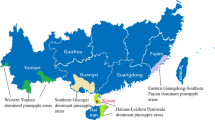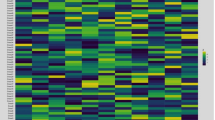Abstract
A single test, including one pseudo-backcross (Pinus elliottii x Pinus taeda) x P. elliottii and open-pollinated families of the pure species progenitors, was established in North Central Florida in December 2007 to study the transfer of the fast-growing characteristics from a P. taeda L. (loblolly pine) parent into the P. elliottii Engelm. (slash pine) background. Several traits were measured in the first growing season: height growth, phenology, tip moth incidence, stem traits, crown architectural and needle traits. Heterosis was evaluated for each trait using analyses of variance by fitting a linear mixed model. All traits were significantly (p value < 0.05) different among families while the significance for heterosis varied by trait. Positive heterosis was found for average rate of shoot elongation (ASRE), total growth (TG), total height and number of needles per fascicle while the opposite was true for base diameter, top diameter, fascicle length, fascicle diameter, crown projected area and phenological traits (cessation, duration and day to reach 50% of the height). Average performance (i.e., no heterosis) was found for initiation of growth, number of branches, number of nodes, tip moth incidence, sheath length and specific leaf area. The analyses indicated that introgression of loblolly pine alleles into slash pine was effective and novel trait combinations were achieved. The pseudo-backcross had larger variation in early height growth than the slash pine families and was taller than all open-pollinated families at the end of the first season. Tip moth incidence was much lower than the loblolly pine family.





Similar content being viewed by others
References
Barnes RD, Mullin LJ (1978) Three-year height performance of Pinus elliotii Engelm. var. elliotii x P. taeda L. hybrid families on the three sites in Rhodesia. Silvae Genet 27:217–223
Borders BE, Harrison WM (1989) Comparison of slash pine and loblolly pine performance on cutover site-prepared sites in the coastal plain of Georgia and Florida. South J Appl Forest 13(4):204–207
Bouchez A, Hospital F, Causse M, Gallais A, Charcosset A (2002) Marker-assisted introgression of favorable alleles at quantitative trait loci between maize elite lines. Genetics 162:1945–1959
Bruce AB (1910) The Mendelian theory of heredity and the augmentation of vigor. Science 32:627–628
Cade SC, Hedden RL (1987) Growth impact of pine tip moth on loblolly pine plantations in the Ouachita Mountains of Arkansas. South J Appl Forest 11:128–133
Chmura DJ, Rahman MS, Tjoelker MG (2007) Crown structure and biomass allocation patterns modulate aboveground productivity in young loblolly pine and slash pine. For Ecol Manag 243:219–230
Colbert SR, Jokela EJ, Neary DG (1990) Effects of annual fertilization and sustained weed control on dry matter partitioning leaf area, and growth efficiency of juvenile loblolly and slash pine. For Sci 36:995–1014
Dallas-Tea F, Jokela EJ (1991) Needlefall, canopy light interception, and productivity of young intensively managed slash and loblolly pine stands. For Sci 37:1298–1313
Dorman KW (1976) The genetics and breeding of southern pines. U.S. Department of Agriculture, Agriculture Handbook 471. Washington, DC
Ehrenberg CE (1963) Genetic variation in progeny tests of Scot pines (Pinus sylvestris L.). Stud For Suec 10:1–35
Emhart VI, Martin TA, White TL, Huber DA (2006) Genetic variation in basal area increment phenology and its correlation with growth rate in loblolly and slash pine families and clones. Can J For Res 36:961–971
Emhart VI, Martin TA, White TL, Huber DA (2007) Clonal variation in crown structure, absorbed photosynthetically active radiation and growth of loblolly pine and slash pine. Tree Physiol 27(3):421–430
Falconer DS, Mackay T (1996) Introduction to quantitative genetics, 4th edn. Longman, White Plains
Fowler DP (1978) Population improvement and hybridization. Unasylva 30:21–26
Franco GAA, Wang S, Melchinger AE, Zeng Z (2008) Quantitative trait loci mapping and the genetic basis of heterosis in maize and rice. Genetics 180:1707–1724
Gezan SA, Huber DA, Medina AM, Parisi LM, Powell GL (2004) Cooperative forest genetics research program. 46th Progress Report. University of Florida, Gainesville
Gezan SA, Huber DA, Medina AM, Parisi LM, Powell GL (2005) Cooperative forest genetics research program. 47th Progress Report. University of Florida, Gainesville
Gilmour AR, Gobel BJ, Cullis BR, Thompson R (2006) ASReml user guide release 2.0. VSN International Ltd, Hemel Hempstead
Gonzalez C (2008) Interactions between xylem structure and water relations of southern pines. Ph.D. Dissertation, University of Florida, Gainesville, FL
Hanover JW (1963) Geographic variation in ponderosa pine leader growth. For Sci 9(1):86–95
Harding KJ, Copley TR (2000) Wood property variation in Queensland-grown slash x caribbean pine hybrids. In: Dungey HS, Dieters MJ, Nikles DG (eds) Proceedings of QFRI/CRC-SPF symposium: hybrid breeding and genetics of forest trees, Noosa, Queensland, Australia, 9–14 April 2000. Department of Primary Industries, Brisbane, pp 160–167
Huber DA, White TL, Powell GL, Rockwood D, Atwood R (2000) Cooperative forest genetics research program. 42th Annual report. University of Florida, Gainesville
Huber DA, Parisi LM, Powell GL, Li X (2007) Cooperative forest genetics research program. 49th Annual report. University of Florida, Gainesville
Jayawickrama KJS, McKeand SE, Jett JB (1998) Phenological variation in height and diameter growth in provenances and families of loblolly pine. New For 16:11–25
Johnsen KH, Butnor JR, Nelson CD, Kush J, Schmidtling R (2009) Hurricane Katrina winds damaged longleaf pine less than loblolly and slash pines. South J Appl Forest 33(4):178–181
King NT, Seiler JR, Fox TR, Johnsen KH (2008) Post-fertilization physiology and growth performance of loblolly pine clones. Tree Physiol 28:703–711
Kinghorn BP (2000) Crossbreeding strategies to maximise economic returns. In: Dungey HS, Dieters MJ, Nikles DG (eds) Proceedings of QFRI/CRC-SPF symposium: hybrid breeding and genetics of forest trees, Noosa, Queensland, Australia, 9–14 April 2000. Department of Primary Industries, Brisbane, pp 291–302
Kraus JF (1986) Breeding shortleaf x loblolly pine hybrids for the development of fusiform rust-resistant loblolly pine. South J Appl Forest 10:195–196
La Farge T, Kraus JF (1980) A progeny test of (shortleaf x loblolly) x loblolly hybrids to produce rapid growing hybrids resistant to fusiform rust. Silvae Genet 29:197–200
Littell RC, Stroup WW, Freund RJ (2002) SAS for linear models, 4th edn. SAS Institute, Cary
Lopez-Upton J (1999) Early growth, pest incidence, and cold hardiness of loblolly pine, slash pine, and some slash pine hybrids. Ph.D. dissertation, University of Florida, Gainesville, FL
Lopez-Upton J, White TL, Huber DA (1999) Taxon and family differences in survival, cold hardiness, early growth, and rust incidence of loblolly, slash pine and some pine hybrids. Silvae Genet 48(6):303–313
Lopez-Upton J, Blakeslee GM, White TL, Huber DA (2000) Effects of the cultural treatments and genetics on tip moth infestation of loblolly pine, slash pine and some slash pine hybrids. For Genet 7(4):275–286
Major JE, Mosseler A, Barsi DC, Campbell M, Rajora OP (2003) Morphometric, allometric, and developmentally adaptive traits in red spruce and black spruce: II. Seedlings and mature tree assessment of controlled intra- and inter-specific hybrids. Can J For Res 33:897–909
Marron N, Ceulemans R (2006) Genetic variation of leaf traits related to productivity in a populus deltoides x populus nigra family. Can J For Res 36:390–400
Martin TA, Jokela EJ (2004) Developmental patterns and nutrition impact radiation use efficiency components in southern pine stands. Ecol Appl 14:1839–1854
McGarvey RC, Martin TA, White TL (2004) Integrating within-crown variation in net photosynthesis in loblolly and slash pine families. Tree Physiol 24:1209–1220
Mirov NT, Duffield JW, Liddicoet AR (1952) Altitudinal races of Pinus ponderosa a 12-year progress report. J Forest 50:825–831
Murthy R, Dougherty PM (1997) Estimating foliage area of loblolly pine shoots. For Sci 43:299–303
Myburg AA, Griffin AR, Sederoff RR, Whetten R (2000) Genetic analysis of interspecific backcross families of a hybrid of Eucalyptus grandis and Eucalyptus globulus. In: Dungey HS, Dieters MJ, Nikles DG (eds) Proceedings of QFRI/CRC-SPF symposium: hybrid breeding and genetics of forest trees, Noosa, Queensland, Australia, 9–14 April 2000. Department of Primary Industries, Brisbane, pp 462–466
National Climatic Data Center (NCDC) US Climate Normals (1971–2000) Products Clim20 Monthly Station Climate Summaries, Climatography of the United States, No. 20. http://www.ncdc.noaa.gov/oa/climate/normals/usnormalsprods.html. Accessed 29 Nov 2007
Nikles DG (2000) Experience with some Pinus hybrids in Queensland, Australia. In: Dungey HS, Dieters MJ, Nikles DG (eds) Proceedings of QFRI/CRC-SPF symposium: hybrid breeding and genetics of forest trees, Noosa, Queensland, Australia, 9–14 April 2000. Department of Primary Industries, Brisbane, pp 27–43
Nikles DG, Robinson MJ (1989) The development of Pinus hybrids for operational use in Queensland. In: Gibson GL, Griffin AR, Matheson AC (eds) Proceedings of IUFRO conference: breeding tropical trees: population structure and genetic improvement strategies in clonal and seedling forestry, Pattaya, Thailand 18 November–3 December 1988, pp 272–282
Parisi LM (2006) Shoot elongation patterns and genetic control of second-year height growth in Pinus taeda L. using clonally replicated trials. M.Sc. thesis, University of Florida, Gainesville, FL
Rasband WS (1997–2005) ImageJ. U.S. National Institutes of Health, Bethesda, MD, USA. http://rsb.info.nih.gov/ij/. Accessed 26 Jan 2009
Richardson DM (1998) Ecology and biogeography of Pinus. Cambridge University Press, Cambridge
SAS Institute (2002–2003) SAS 9.1 help and documentation. SAS Institute, Cary
Shull GH (1908) The composition of a field of maize. Am Breeders Assoc Rep 4:296–301
Stephen FM, Wallis GW, Colvin RJ, Young JF, Warren LO (1982) Pine tree growth and yield: Influence of species, plant spacing, vegetation, and pine tip moth control. Ark Farm Res 31:10
Strickland R, Goddard R (1965) Inheritance of branching and crown characteristics in slash pine. In: Proceeding 8th southern conference on forest tree improvement, June 16–17, Savannah, GA, pp 57–63
Thomas BP, Cummings E, Wittstruck WH (1985) Soil survey of Alachua County, Florida. US Department of Agriculture, SCS
Van Der Sijde HA, Roelofsen JW (1986) The potential of pine hybrids in South Africa. South Afr Fort J 136:5–14
White TL, Adams WT, Neale DB (2007) Forest genetics. CABI Publishing
Will RE, Barron GA, Burkes EC, Shiver B, Teskey RO (2001) Relationship between intercepted radiation, net photosynthesis, respiration, and rate of stem volume growth of Pinus taeda and Pinus elliottii stands of different densities. For Ecol Manag 154:155–163
Williams ER, John JA, Whitaker D (1999) Example of block designs for plant and tree breeding trials. Aust N Z J Stat 41(3):277–284
Wright JW (1976) Introduction to forest genetics. Department of Forestry Michigan State University, East Lansing, MI. Academic Press, (AP) New York
Xiao Y, Jokela E, White TL (2003) Species differences in crown structure and growth performance of juvenile loblolly and slash pine. For Ecol Manag 174:295–313
Zobel B, Talbert J (1984) Applied forest tree improvement. Wiley, New York
Acknowledgments
This research was funded by the CFGRP under the USDA Conifer Translational Genomic Network (CTGN) grant. Thanks to the CFGRP cooperators, in particular, to the University of Florida, Plum Creek Timber Company and Smurfit-Stone Container Corporation for the materials used in the project. We thank Greg Powell, Carlos Gonzales, Pablo Pinedo, Xiaobo Li, Andres Susaeta, Claudio Verdugo, Rodrigo Vergara and Alejandro Riveros for their help in data collection. Thanks to Tim Martin, Gary Peter and Salvador Gezan for their useful comments and discussion about the project.
Author information
Authors and Affiliations
Corresponding author
Additional information
Communicated by: D. Grattapaglia
Rights and permissions
About this article
Cite this article
Muñoz Del Valle, P.R., Huber, D.A. & Butnor, J.R. Phenotypic analysis of first-year traits in a pseudo-backcross {(slash x loblolly) x slash} and the open-pollinated families of the pure-species progenitors. Tree Genetics & Genomes 7, 183–192 (2011). https://doi.org/10.1007/s11295-010-0324-8
Received:
Revised:
Accepted:
Published:
Issue Date:
DOI: https://doi.org/10.1007/s11295-010-0324-8




